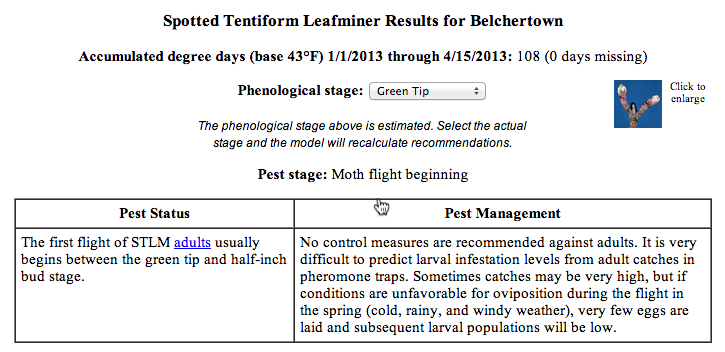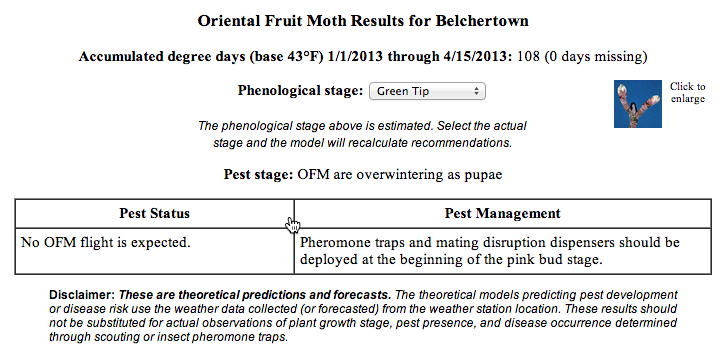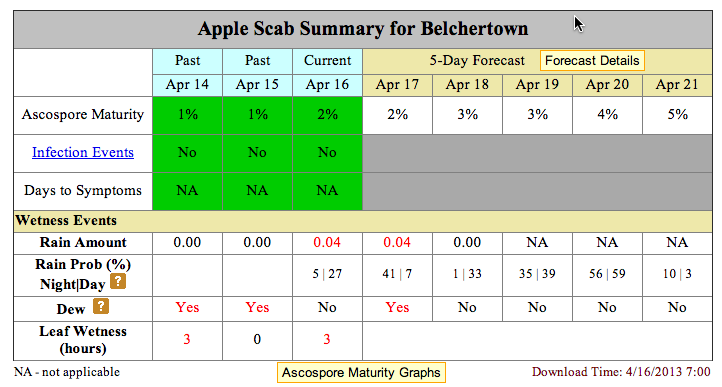

Current degree day accumulations
2013 New England Tree Fruit Management Guide available
Location: UMass Cold Spring Orchard, Belchertown, MA
9-April, 2013 |
|
| Base 43 | 92 |
| Base 50 | 33 |
Location: UMass Cold Spring Orchard, 15-April, 2013
| Honeycrisp apple | early green tip |
| McIntosh apple | green tip plus |
| Rainier cherry | swollen bud |
| PF-14 Jersey peach | very swollen bud |
| Gold Bosc pear | swollen bud |
See pictures of current bud stages here: http://extension.umass.edu/fruitadvisor/2013-bud-stages-0
| Coming events | Degree days (Base 43) |
| Green fruitworm flight peak | 102-216 |
| Pear psylla adults active | 31-99 |
| Pear psylla 1st oviposition | 40-126 |
| Redbanded leafroller 1st catch | 110-178 |
| Spotted tentiform leafminer 1st catch | 113-213 |
| McIntosh silver tip | 60-110 |
| McIntosh green tip | 95-147 |
APRIL 16 (Tuesday): UMass Fruit Team Twilight Meeting, Big Apple, 207 Arnold St., Wrentham. MA. 5:30 PM. 1 pesticide re-certification credit will be available. $20/25 meeting charge.
http://extension.umass.edu/fruitadvisor/events/fruit-twilight-meeting
APRIL 17 (Wednesday): Harmonized Good Agricultural Practices (GAP) Training, 249 Lakeside Drive, Marlboro, MA.10 AM to 4 PM.
http://extension.umass.edu/fruitadvisor/events/harmonized-good-agricultural-practices-gap-training
APRIL 17 (Wednesday): UMass Fruit Team Twilight Meeting, Outlook Farm,136 Main Rd., Westhampton, MA. 5:30 PM. 1 pesticide re-certification credit will be available. $20/25 meeting charge.
http://extension.umass.edu/fruitadvisor/events/fruit-twilight-meeting-0
It's fairly quiet although I suspect many are gearing up for that first oil spray. (Only if the weather stays mild.) Macs are at green tip but not moving real fast -- at this rate, it is going to be a late bloom. Insect activity has been minimal but scab and midew will be big players by next week. I hope to see you at this week's twilight meetings. JC
The 2013 2013 New England Tree Fruit Management Guide is available here: http://www.umassextensionbookstore.com/store.php?crn=238
The cost is $50 payable by credit card. Copies of the Guide may be available to purchase with cash next week at the Twilight Meetings, however, there is a limited supply -- first come, first served.


There was a prolonged infection event last Friday into Saturday but it was barely green tip and apple scab spore maturity was questionable. Now the clock is ticking and it will be important to maintain good fungicide coverage for scab. Below is today's NEWA outpur for scab. (I am not sure why it is not predicting infection events?)

Regarding bacterial canker control on sweet cherry, see this recent blog post by Win Cowgill of Rutgers:
http://jerseyfruitagupdates.blogspot.com/2013/04/spray-cherry-trees-for-bacterial-canker.html
By Julie Carroll. Reprinted from Scaffolds Fruit Journal, Vol. 22, No.43, April 15, 2013. http://www.scaffolds.entomology.cornell.edu/index.html
Several inquiries regarding degree days have surfaced in the past as NEWA (Network for Environment and Weather Applications, newa.cornell.edu) use has increased. Degree days (DD) are, essentially, a mathematical way to calculate the accumulation of heating units over time. (Cooling units, i.e., chilling hours, can also be calculated, though this is not currently programmed into NEWA.) A brief description of DDs is available from the University of Illinois at http://ipm.illinois.edu/degreedays/calculation.html.
Keep in mind:
• NEWA serves many agricultural and horticultural commodities.
• There are several formulas that can be used to calculate degree days.
• Max and Min temperatures are collected during a "defined" 24-hour period.
Because DDs are a way of expressing heating units, entomologists, plant pathologists, horticulturists, and agronomists have utilized DD calculations to model the development (phenology) of arthropod pests, plant diseases, plants, crops, and weeds. For instance, we know that the best fit for explaining the development of ascospores of the apple scab fungus is by using degree days calculated with a low cutoff temperature of 32°F. We also know that codling moth development does not progress below 50°F. This is also the case for most plants, thus DDs calculated with a base temperature (or low cutoff) of 50°F are commonly referred to as growing degree days, or GDDs.
Several crop, pest, and disease phenology models are programmed into NEWA. Some rely solely on DD tables, some display results directly (so the DD accumulations are not apparent to the user), and some provide DD ranges when IPM decisions and interventions are needed (hanging traps, timing sprays, etc.).
Degree Days (DD) calculated in NEWA at http://newa.cornell.edu/index.php?page=degree-days and the insect phenology and disease models for which they were developed.
Base Temp Insect Phenology Model or Disease Development Model
| 4°C | cabbage maggot |
| 0°C | apple scab |
| 40°F | onion maggot |
| 43°F | obliquebanded leafroller, spotted tentiform leafminer |
| 45°F | oriental fruit moth |
| 47.14°F | grape berry moth |
| 48°F | alfalfa weevil |
| 50°F | growing degree days (GDD), codling moth, plum curculio, apple maggot |
| 55°F | fire blight shoot blight symptom development |
Implementation of these models is guided by research and extension faculty at Cornell University, as well as extension educators in Cornell Cooperative Extension. NEWA also provides a platform for stakeholder input to improve model performance and webpage results. For example, if you are looking at the "Results" pages generated by the Apple Insect Models on NEWA, those screens are generated by accumulating temperature data for the location of interest, generating a DD value (using Baskerville-Emin calculations, see below), and then comparing that total against a lookup table of DD ranges and corresponding text messages that are used to populate the Pest Status, Pest Development, and Pest Management boxes on the screen.
In NEWA, historically, the simple Max-Min formula has been used for DD calculations. This formula can readily be calculated by hand and was also included in many of the Cornell Pest Management Guidelines. The Baskerville-Emin (BE) formula uses a sine wave algorithm and results in more precise DD calculations. This formula was implemented in NEWA in ~2006.
We chose to place the simple DD formula choices at the top of the drop-down selection list on the NEWA
Degree Day Data webpage http://newa.cornell.edu/index.php?page=degree-days to reduce confusion among our long-time NEWA users. Those choices that use the BE DD formula are noted as "BE" in the name. Currently, in all the NEWA apple disease and apple insect phenology models that utilize DD accumulations, the BE formula is being used. Kerik Cox and Art Agnello have chosen to use BE DDs because of their higher precision. Furthermore, BE DDs have been used in the entomology field observations in Geneva, NY, for the past 25 years or more.
If you are comparing the Scaffolds "Upcoming Pest Events" tabulated DDs with what is tabulated for Geneva in NEWA, make sure you compare these with the BE DDs to get the best match. "Best match" because, having used two calculators to crunch an involved equation and come up with two answers that don't exactly match, it is true that software programs can differ slightly in the way they handle rounding of decimal places, etc., which can create some differences in the mathematical answer.
Another area that introduces variability in DD accumulations is how the 24-hour period is defined. For some, the 24-hour day begins at midnight, and for some it ends at midnight. That is, in some systems midnight is 0:00, in some it is 24:00. In NEWA, midnight marks the beginning of the day and is tabulated as 0:00 in the Hourly Data pages. NEWA's 24-hour period runs from 12:00 AM (= 0:00) until 11:59 PM. Data is collected for NEWA's database at the top of the hour. Therefore, some NEWA weather stations may miss the true Max and true Min temperature for a given day, because it might have occurred at 2:16 PM. Hence, this adds another source of variability! Consequently, NEWA's new weather stations with the IP100 ethernet interface, described at http://newa.cornell.edu/index.php?page=get-weather-station, will be programmed to collect the true daily Max and Min values.
Daylight savings time can be problematic. Essentially, an hour is lost and then gained in the annual time continuum. NEWA will soon begin utilizing the same methodology as the National Weather Service (NWS) for dealing with this 23-hour-long day and 25-hour-long day during the year. The NWS has Weather Observer sites reporting daily Max and Min temperatures. These sites collect data, once per day, at specified times, which can affect DD value calculations. Consider the time when you look at the values from your Max-Min thermometer and then clear them. If you look at these first thing in the morning and invariably at 5:00 AM, then you are collecting a true 24-hour Max and Min temperature for the period 6:00 AM until 5:00 AM the following day. If you collect this data in the afternoon, the 24-hour period range would be different. Over time, climatologists have found that "afternoon" observations typically accumulate more DD's than "morning" ones.
When comparing DD data, keep in mind the sources of variability in DD accumulations. And don't sweat the discrepancies you find too much; like they say, "you can measure it with a micrometer, but what's the sense if you have to cut it out with a hatchet?" Nothing is more accurate than looking outside and seeing if you have green tip or counting the insects in your traps. We certainly don't expect an adult codling moth to pop out on the dot at 489 DD (base 43°F) from Jan 1, or plum curculio to stop immigrating into the orchard at 308 DD (base 50°F) from petal fall; there are simply too many sources of variability (e.g., in whose data one is using, how it was collected, at how representative a site, and at what point in time, etc.) to make this level of tracking practical.
NEWA provides theoretical predictions and forecasts. The theoretical models predicting pest development or disease risk use the weather data collected (or forecasted) from the weather station location. These results should not be substituted for actual observations of plant growth stage, pest presence, and disease occurrence determined through scouting or insect pheromone traps.
UMass Fruit Advisor: http://umassfruit.com
Scaffolds Fruit Journal: http://www.nysaes.cornell.edu/ent/scafolds/
Network for Environment and Weather Applications (NEWA): http://newa.cornell.edu
Follow me on Twitter (http://twitter.com/jmcextman) and Facebook (http://www.facebook.com/jmcextman)
UMass Vegetable & Fruit IPM Network (on Facebook, http://www.facebook.com/umassipmteam)
The next Healthy Fruit will be published on Tuesday, April 23 or thereabouts, 2013. As always feel free to get in touch with any member of the UMass Fruit Team (http://extension.umass.edu/fruitadvisor/team-members) if you have questions or comments.